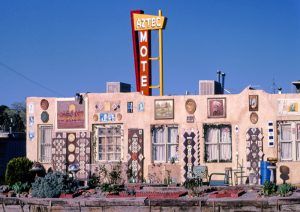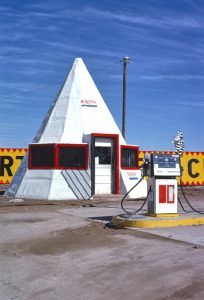
Palace Amusements in Ashbury Park, New Jersey by John Margolies, 1978.
My parents’ generation thought it was the ugliest stuff in the world. I liked places where everyone screamed for attention: ‘Look at me. Look at me.’
— John Margolies to the Washington Post, 2015
John Margolies was a fantastic photographer, author, and architectural critic who captured thousands of photographs of buildings and roadside attractions between 1969 and 2008. His collection of almost 12,000 color slides that share a view of American History that represents views of main streets, buildings, and signage was acquired by the Library of Congress.
His focus was on the trends of the times, such as restaurants, gas stations, movie theaters, motels, signage, and beach and mountain vacation resorts that he seemingly knew would no longer exist in the near future. Many places he photographed no longer exist today.
John Samuel Margolies was born on May 16, 1940, in New Canaan, Connecticut, to Asher and Ethel Polacheck Margollies. John Margolies became interested in roadside attractions as a child, riding in the backseat of his parent’s car on trips to neighboring Hartford. During these road trips, he would beg his parents to stop at roadside attractions, but they refused, believing them ugly.
When he turned 16 and obtained his driver’s license, he began sightseeing in his 1948 Oldsmobile.

Eden Roc Hotel in Miami, Florida, courtesy Wikipedia.
Margolies studied at the University of Pennsylvania, earning a bachelor’s degree in art history and journalism and a master’s in communications.
After graduating, Margolies worked as an editor at Architectural Record and served as the Program Director of the Architectural League of New York, where he organized the Environment Postmodern exhibition series. In 1970, he organized an exhibit, “The Architecture of Joy,” about Morris Lapidus, who designed the Eden Roc hotel resort in Miami, Florida. Margolies further provoked modernists, who disliked his taste in architecture, with an essay in Progressive Architecture in November 1973, lauding the Madonna Inn, a Swiss-chalet-themed resort in San Luis Obispo, California, that was built by a couple with no formal design experience. The exhibition horrified Margolies’s architectural purist peers.
By then, Margolies had left New York for Santa Monica, California. He, Billy Adler, and Ilene Segalove set up the collective Telethon to document what they called “the television environment.” Margolies took a parting shot at New York in 1971, describing it as “that black hole of Calcutta.”
In 1972, he began to take long road trips spending much of his time scouring back roads for vanishing emblems of the midcentury enterprise and novelty architecture. He knew little about photography initially but mastered the task, utilizing Canon cameras, a 50mm lens, and slow slide film. Renting the largest car he could afford, usually a Cadillac; he spent as many as eight weeks at a time looking for sites that he believed the growing modernist trend would displace. His trips often began in the spring or after Labor Day, when families and tourists were not crowding the roads. Staying in motels, he also packed “coolers for keeping the film cool, as well as his personal items and clothing. He preferred to photograph early mornings with cloudless, blue skies and often skipped photo opportunities if the light wasn’t right or cars blocked the scene. His photographs did not include people, a deliberate choice to reduce visual distraction. And unlike other famous photographers like Ansel Adams, he rarely photographed wildlife or nature.
I love the light at that time of day; it’s like golden syrup. Everything is fresh, and no one is there to bother you.
— John Margolies to Roadside America

Aztec Motel, Albuquerque, New Mexico Art Detail by John Margolies, 2003.
In his photography, Margolies utilized a straightforward, unsentimental approach that emphasized the form of the buildings. Margolies’ eye was often drawn to signage or other graphic elements of buildings that expressed the ingenuity or eccentricity of their makers. These were often unique and bizarre buildings and sculptures along the roadside.
From the start, Margolies knew franchising and changing fashions endangered the quirky motels, miniature golf courses, diners, billboards, and gas stations. At the same time, automobile traffic patterns were changing as drivers opted for the high-speed limits of interstates and the convenience of service areas, leaving the old local highways less traveled.
Margolies’ photography and writing contributed to shaping the postmodernist movement. In 1978, Margolies was awarded a Guggenheim Fellowship. The Howard Gilman Foundation, the National Endowment for the Arts, and the Wyeth Endowment for American Art also supported him. In 2003, he was named Josephine Patterson Albright Fellow by the Alicia Patterson Foundation.
In his book, The End of the Road: Vanishing Highway Architecture in America, published in 1981, Margolies warned that modernism threatened to displace such popular establishments. That same year, he exhibited his photographs at the Hudson River Museum in Yonkers, New York. Architecture critic Paul Goldberger described this show as “pure joy” and “an articulate plea against the homogenization of the American landscape.”
“The architectural historian John Margolies must surely be the father of this entire movement — he has led dozens of his colleagues toward an appreciation of those buildings that might be called the exclamation points of the landscape.”
Paul Goldberger, Architecture Critic, writing in the New York Times
Over more than 30 years and 100,000 miles, Margolies produced tens of thousands of images, resulting in a spate of richly illustrated books, including “John Margolies: Roadside America” in 2010, with text by the design writer Phil Patton and the architectural historian C. Ford Peatross.
Starting in 2007, the Library of Congress began to acquire his photographs and created the public domain John Margolies Roadside America Photograph Archive in 2016, consisting of 11,710 color slides taken across America between 1969 and 2008. Approximately half of the slides show sites in California, Florida, Michigan, New Jersey, New York, South Carolina, and Texas, but all 48 contiguous states are represented.
The Library of Congress credits Margolies with shaping the postmodernist movement. The original slides are kept in cold storage to preserve them. Today, this collection of Marogolies’ photographs offers an invaluable tour of the United States’ diverse vernacular architecture and signage.
Margolies was also a noted collector of postcards, brochures, maps, and other travel ephemera. He also collected other artifacts of American culture, including vintage photographs, retail signs, pennants, matchbooks, and more.
Other books published by Margolies include Pump and Circumstance: Glory Days of the Gas Station in 1993, Home Away From Home: Motels in America in 1995), and Fun Along the Road: American Tourist Attractions in 1998.
John Margolies died of pneumonia in Manhattan, New York, on May 26, 2016.
© Kathy Alexander/Legends of America, May 2023.
Also See:
Lost Landmarks & Vanished Sites
Off-Beat & Roadside Attractions
Sources:
Design Boom
Library of Congress
New York Times
Public Domain Review
Wikipedia



